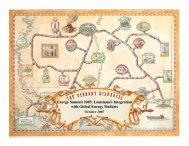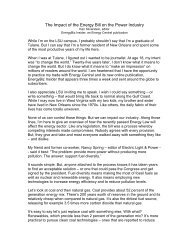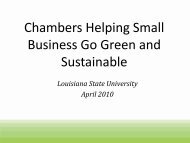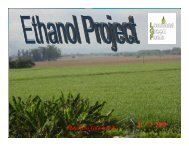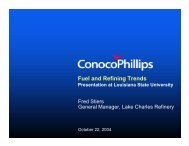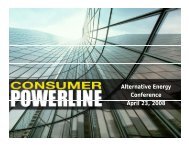Who is Agrilectric?
Who is Agrilectric?
Who is Agrilectric?
You also want an ePaper? Increase the reach of your titles
YUMPU automatically turns print PDFs into web optimized ePapers that Google loves.
<strong>Who</strong> <strong>is</strong> <strong>Agrilectric</strong>?
• <strong>Agrilectric</strong> owns andoperates a 13 -megawattpower plant (“Facility”)located adjacent to a ricemill near Lake Charles,Lou<strong>is</strong>iana• The Facility generatesgreen power by burningrice hulls (300 tons perday) obtained from arearice millers• The Facility was built in1984 and <strong>is</strong> a QualifyingFacility under PURPA• It supplies power to theadjacent rice mill andexcess power <strong>is</strong> currentlysold to the utility atavoided cost• Has taken anenvironmental liability and
Availability Factor
Capacity Factor
What <strong>is</strong><strong>Agrilectric</strong> doingto promote GreenPower in theUnited States?
Renewable energy options must sat<strong>is</strong>fy threeconditions:1. Resource availability2. Technical maturity3. Policy and economic environment that supportscommercialization
<strong>Agrilectric</strong> <strong>is</strong> aleading member of theUnited States ofAmerica BiomassPower ProducerAllianceWWW.USABPPA.COM
The International EnergyAgency(IEA)• Estimates that renewable energy sourcesaccount for about 13% of the world’s totalprimary energy supply.• Nearly 80% of these renewable are in theform of combustible biomass-mostly wood,charcoal, crop residues, or other wastes.
What <strong>is</strong> Open-Loop Biomass• Forest Sources (FromMills, Timber,Harvesting,Thinning, etc.)• Solid Waste Wood(Except Treated Wood,MSW, or CommonlyRecycled Paper)• Lignin (Black Liquor)• Agricultural CropResidues• No Fossil Fuel Cofiring,Except forStartup and FlameStabilization
USABPPA Leg<strong>is</strong>lativeAgenda
Section 45 Electricity Creditfor Open-Loop Biomass• New Plants in Service after 8-8-05 through12-31-08 (“New” means 80% NewProperty)• Credit Life: 10 years from in Service Datefor New Facilities (5 years ending 2009 forUsed Plants)• Credit Amount: 0.9 Cents/KWh in 2005,Adjusted Annually for Inflation (50% of“Wind”)• Reduced up to 50% for Grants & Tax-Exempt Financing
Geaux GreenIt’s a Good Choice for Lou<strong>is</strong>iana!• Available for purchase in Lou<strong>is</strong>iana,beginning April 2007• Can be purchased voluntarily by consumersand businesses who want to do their part toreduce greenhouse gases and dependenceon fossil fuels• All power generated for th<strong>is</strong> pilot program <strong>is</strong>produced in Lou<strong>is</strong>iana, using biomass fuelsfrom agricultural byproducts grown inLou<strong>is</strong>iana
<strong>Agrilectric</strong>’s Participation inthe Green Power Program:• Will deliver 21,000 MWh from April 2007through March 2008• Green power will be priced at $59 perMWh
<strong>Agrilectric</strong>’s Concerns with theRenewable Energy PilotProgram:• A one year pilot program, <strong>is</strong> simply too short of time, to properlygauge the feasibility of implementing a renewable portfolio standard.• Any long term program should require that renewable suppliers bidin their product price, and allow competitive forces to determine theleast cost renewable supplier.• Providing preference to commercial operation that began afterJanuary 1, 1997 d<strong>is</strong>criminates against and ignores the contributionsof ex<strong>is</strong>ting renewable suppliers in the state.• There <strong>is</strong> no fixed cost power, being offered in the program, to ratepayers.Even though th<strong>is</strong> power has a fixed cost to the utility. Th<strong>is</strong>could dramatically decrease the potential participation of commercialaccounts.
<strong>Agrilectric</strong>’s Concerns (cont.)• The current program does not provide supplier with the greater ofthe renewable program pricing and usual Avoided Cost pricing.• Suppliers must wait until completion of the program, to get paid forthe net difference between the program pricing and Avoided Cost.• <strong>Agrilectric</strong> questions incentive to Entergy, to make th<strong>is</strong> programsuccessful.
ANewEraForBiomass
OVERVIEW1. Paradigm Shift – From Selling Powerto Selling Attributes2. Renewable Energy CreditsA. Voluntary MarketsB. Involuntary MarketsC. OwnershipD. Challenges3. Greenhouse Gas Credits
OLD WORLDPPAPower PlantUtility/Buyer ofCommodity Power
NEW WORLDPPAREC’sGHG’sCustomer “B”Customer “C”NOXCustomer “D”SO 2HGERC’sCustomer “E”Customer “F”Customer “G”
RENEWABLE ENERGYCREDITS/REC’S(aka TRC’s, Tags, Attributes—They All Mean The Same!!)• Value entirely a function ofRPS mandate and the numberof generators who qualify.• Majority of States have someform of an RPS.• www.dsireusa.org.
RPS Targets1. Example from Various States• Maine: 30% by 2000 (includes natural gas)• Massachusetts: 4% by 2009, 1%thereafter,(limited to “new” and strict definition ofbiomass)• California: 20% by 2017• Minnesota: 19% by 2015• Pennsylvania: 25% by 20132. Different definitions of what constitutes“renewable”makes REC markets a complicated patchworkof incentives
<strong>Who</strong> Participates in REC Markets?• Sellers are Generators• Buyers are (1) Parties who need tocomply with RPS, (2) Hedge Funds, (3)Traders• Brokers frequently participate andadd value (Evolution, Element Markets,Natsource, Cantor Fitzgerald)• State Renewable Funds offer pricecollars, i.e. Massachusetts RenewableTrust, Ct 100.
Value of Mandatory REC MarketsCalifornia:Low liquidity. Low price. Spot prices $0.50 MWh – 2007-2008 trades in $3.00 range.PJM:NJ <strong>is</strong> regulatory driver: 2.5% by 2008. Compliance Cap <strong>is</strong>$50.Class I – $7.00. Class II - $4.00.NEPOOL:Wide variability in price. Massachusetts REC’s tradingnorth of $50.00. CT REC’s trading at high $30’s/low $40’s.Maine at $0.50.
Definitional Issues• Wide variety of opinion on who ownsREC’s in PURPA contracts. FERC andnumerous states have ruled on <strong>is</strong>sue.Issue remains unresolved.• All new contracts will need tospecifically define what <strong>is</strong> beingconveyed and whether attributesinclude all “environmental attributes”.
Renewable energy options must sat<strong>is</strong>fy threeconditions:1. Resource availability2. Technical maturity3. Policy and economic environment thatsupportscommercialization
<strong>Agrilectric</strong> Power3063 HWY 397Lake Charles, Lou<strong>is</strong>iana70615Thomas J. SpiesChief Operating Officer(225) 922-4662tspies@powellgroup.com





